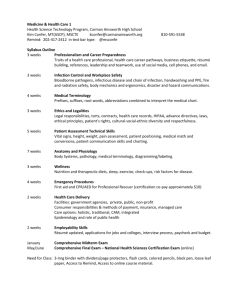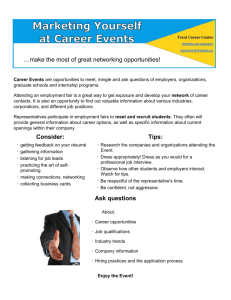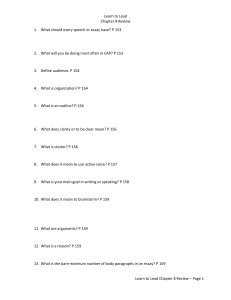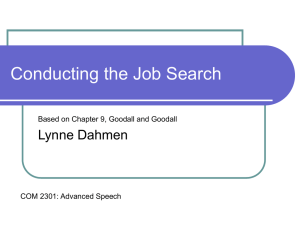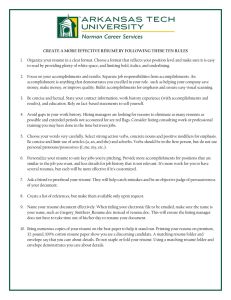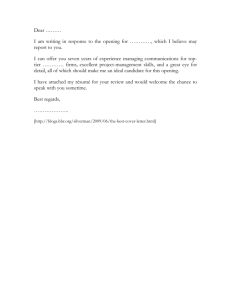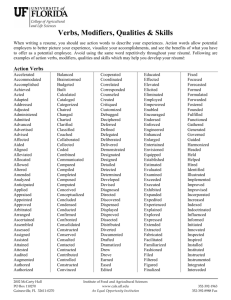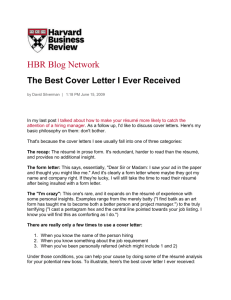Tips for Writing a High Impact Résumé
advertisement
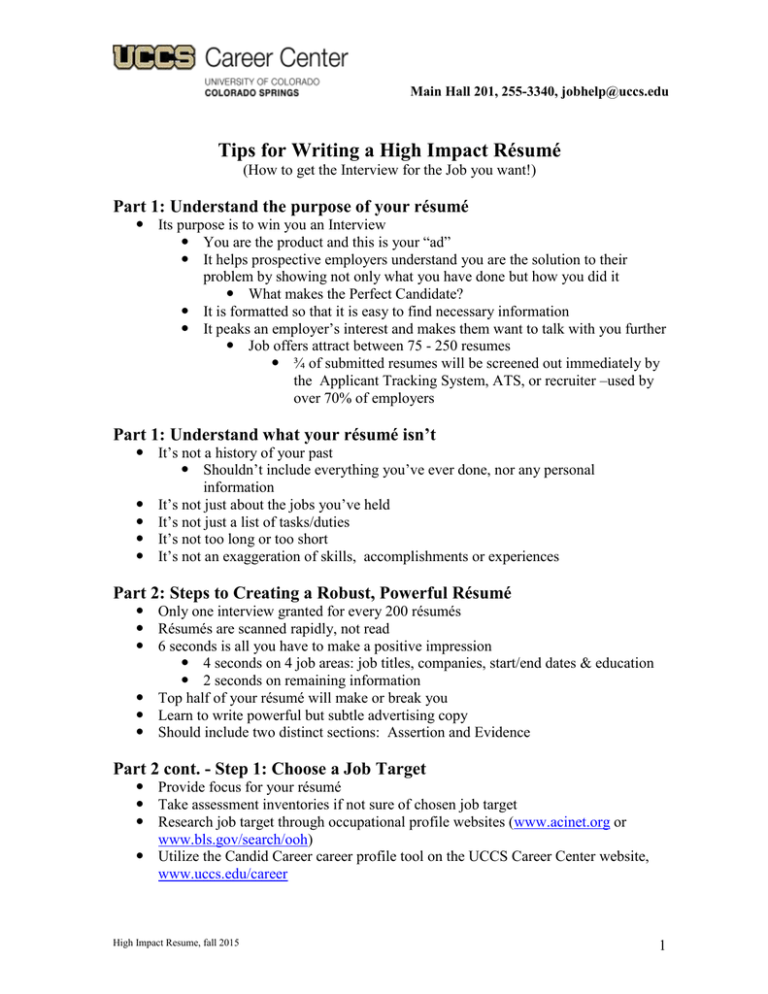
Main Hall 201, 255-3340, jobhelp@uccs.edu Tips for Writing a High Impact Résumé (How to get the Interview for the Job you want!) Part 1: Understand the purpose of your résumé Its purpose is to win you an Interview You are the product and this is your “ad” It helps prospective employers understand you are the solution to their problem by showing not only what you have done but how you did it What makes the Perfect Candidate? It is formatted so that it is easy to find necessary information It peaks an employer’s interest and makes them want to talk with you further Job offers attract between 75 - 250 resumes ¾ of submitted resumes will be screened out immediately by the Applicant Tracking System, ATS, or recruiter –used by over 70% of employers Part 1: Understand what your résumé isn’t It’s not a history of your past Shouldn’t include everything you’ve ever done, nor any personal information It’s not just about the jobs you’ve held It’s not just a list of tasks/duties It’s not too long or too short It’s not an exaggeration of skills, accomplishments or experiences Part 2: Steps to Creating a Robust, Powerful Résumé Only one interview granted for every 200 résumés Résumés are scanned rapidly, not read 6 seconds is all you have to make a positive impression 4 seconds on 4 job areas: job titles, companies, start/end dates & education 2 seconds on remaining information Top half of your résumé will make or break you Learn to write powerful but subtle advertising copy Should include two distinct sections: Assertion and Evidence Part 2 cont. - Step 1: Choose a Job Target Provide focus for your résumé Take assessment inventories if not sure of chosen job target Research job target through occupational profile websites (www.acinet.org or www.bls.gov/search/ooh) Utilize the Candid Career career profile tool on the UCCS Career Center website, www.uccs.edu/career High Impact Resume, fall 2015 1 Make one strong résumé for chosen job industry. If you are considering several industries, make matching résumés Part 2 cont. - Step 2: Know key words for each Job Target Research job descriptions in chosen field/s (www.simplyhired.com – also shows LinkedIn contacts) 50% of applicants don’t meet minimum qualifications – only spend 50 seconds reading the job description Match key words and incorporate into résumé 1st résumé screening step is using an ATS system Estimated that 90% of applicants don’t customize their résumés Don’t just paste in key words – use content as well to describe Look for the KSAs of a particular job and incorporate those words into résumé (Knowledge, Skills, Abilities) Need to be strategically placed (at the top) Use a word cloud tool to see key words in job posting Wordle.net (needs Java), TagCrowd.com Part 2 cont. - Step 2: Know Key Words for Each Job Target Example of word cloud using job description: Part 2 cont. - Step 3: Include a Heading Your name – most important piece of the résumé – it needs to stand out and be easy to read At the top of Page One & typed right into the body of your résumé not in the Header. Put mini-heading at top of subsequent page Bold it with a bit larger font size than the rest of your résumé Street Address – better than a P.O. Box If you’re planning/willing to move, address that in cover letter Phone Number – different area codes don’t matter as much Pick one number you’ll answer & list it Check your voicemail message for clarity and politeness Email Address – your entire name if possible Obtain a new email address for your job search – be sure to check it Make it professional - not disgusting, cute or juvenile Can also include LinkedIn address and/or web address if relevant High Impact Resume, fall 2015 2 Part 2 cont. - Step 4: Include a Professional Profile/Summary section This is part of the Assertion section – don’t make employer go through whole résumé trying to figure out what you can offer them: Can include targeted position in Profile/Summary section Summary of Qualifications for Marketing Assistant Profile of Manager Trainee Consists of several short, concise statements that focuses attention on your most important qualities, achievements and abilities; place at the top of the résumé Summarizes the experiences you’ve had to target the job for which you’re applying Can also include a targeted Career Objective statement at the end Choose from: Short, bulleted phrases describing your profession’s desired characteristics Statement of broad or specialized expertise Two or three statements summarizing your specialized skills or personal characteristics (Should be the only paragraphed format in your résumé) Part 2 cont. - Step 4: Include a Professional Profile/Summary Section The most common ingredients of a well-written Summary are as follows. Of course, you would not use all these ingredients in one Summary. Use the ones that highlight you best A short phrase describing your profession (summary of experience/training) Followed by a statement of broad or specialized expertise Followed by two or three additional statements related to any of the following: breadth or depth of skills unique mix of skills range of environments in which you have experience a special or well-documented accomplishment a history of awards, promotions, or superior performance commendations One or more professional or appropriate personal characteristics A sentence describing professional objective or interest Part 2 cont. - Step 5: List your Strongest Skills Still part of the Assertion section Think about how you will solve the employer’s problem Include relevant skills and strengths required for target job Include these relevant skills and strengths in a “Summary of Skills” section on your résumé and place it at the top of your résumé after “Professional Profile” or as part of “Summary of Qualifications” Can modify “Skills” section to include “Technical Skills” or “Clinical Skills” or “Teaching Skills” or “Laboratory Skills” if it is appropriate to your major Part 2 cont. - Step 6: Make a List of your Training and Education Begin with highest degree (either completed or in progress) Include accomplishments such as GPA if over 3.5 (3.0 for engineering) Include any Dean’s Lists, Honor Societies, etc. to show personal traits and characteristics Can also list clubs, groups, etc. to show extra-curricular activity Can include special projects or senior projects here or in experience section High Impact Resume, fall 2015 3 Can include relevant coursework No need to include lower levels of education unless Associate’s degree completed is relevant to job target Include any other training, workshops, seminars, projects, independent studies, etc. to highlight additional education Part 2 cont. - Step 7: Choose Résumé Format – Evidence Section Chronological Résumé (usually reverse order – focus on jobs held) Functional Résumé (focus on skills) Desire to focus on transferable skills To downplay work gaps Have over 10 years of work experience in different fields Are changing careers Re-entering the work force New college graduate with a lot of previous experience Combination Résumé (contains components of both Reverse-Chronological and Functional) When you want to utilize the best of the other two types When you want to have a separate “Accomplishment” section but don’t want to reduce the “Experience” section Part 2 cont. – Step 7: List All of your Jobs in Reverse-Chronological Order Most common résumé form Include work history, including internships or volunteer experience Use if you have a clear job target The next job target is the logical progression Use when you have little or no job experience Use when you have Senior Management experience Part 2 cont. - Step 8: For Each Job task list an Accomplishment – Evidence Section Write down job tasks first (this is what you did) Expand job tasks to include accomplishments for those tasks (this is how you did it and results of how well you did it) Two types of statements: Statements about money Statements that quantify non-monetary results Quantify whenever possible – using numbers to describe shows a more powerful accomplishment – think about bottom lines! Use powerful action verbs but not the same one in the same section Include key words from job description Ask yourself questions such as “How did I help my company?”, then incorporate your answers in to statements no longer than 2 lines Including accomplishments in your work history shows prospective employers how recently you used certain skills Don’t use abbreviations that can’t be read by the ATS High Impact Resume, fall 2015 4 Part 2 cont. - Step 8: Use Action Statements Use bullet points, rather than long wordy sentences (remember the 6 second rule) Use power verbs such as achieved, accomplished, certified, delegated, implement, supervise, train Never use “responsible for” or “duties included” starts to your tasks and accomplishments Be consistent with your verb tense – present or past Part 2 cont. - Step 8: Sample Accomplishment Statements “Coordinated eight city-wide fund-raising events, raising five times as much as the expected $50,000 goal” “Improved office efficiency and customer service by overhauling previously haphazard filing system” “Led team to increase recycling rates of up to 49 percent monthly; achieved 100 percent compliance during eight vigorous inspections” “Attained fast-track promotion through series of increasingly responsible positions” “Trained five new employees on restaurant operations procedures” “Produced total meal sales 20 percent higher than those of other servers in the restaurant” “Directed team of 3 classmates to complete marketing project on time” Part 2 cont. - Step 9: Be Reader Friendly – Do’s Most résumés, 1 page; 10-15 years or more, 2 pages Simple clean structure, easy to read, balanced, symmetrical, uncrowded with some visible white space Make sections easy to find (remember 6 second rule) Writing in sections no more than 6 lines Use bullets in most sections Consistency in boldface, italics, underlining, capital letters, etc. Expand your margins in order to keep résumé to one page and to provide some space between sections. If it’s too crowded better to go to two pages Use nothing less than 10 font Be sure to: Tailor your résumé for the job target; have more than one résumé if more than one job target Use accomplishment based experiences with key words included Always include a cover letter Use good quality paper Font is important, do not use fancy script (standard use is Arial) Needs to be aesthetically pleasing and sophisticated Top 5: Calibri, Helvetica, Georgia, Arial, Garamond Proof-read Clean up Facebook and any other social media account Update LinkedIn profile with new accomplishments High Impact Resume, fall 2015 5 Part 3 - Most Common Mistakes – Don’ts Too long or too short: one page or two full pages, not too crowded Faulty writing style: poor grammar, spelling errors, typos, poor punctuation, overuse of same verbs Converting to PDF file – most ATSs cannot read PDF file Hard to read: layout disorganized or not logical, sections hard to find Poorly typed or reproduced: looks unprofessional, sloppy layout and poor quality paper Inconsistent use of periods at the end of a phrase or sentence (either use them on all sentences/phrases or on none) Including pictures; The use of “I” Listing controversial topics (politics, religion) Poor description of experiences (task oriented instead of accomplishment based) Leaving out computer skills Including personal statistics Lack of key word matches – no customization Overselling and exaggerating References listed on résumé or “Available Upon Request” Part 4 – Contact Information Tips Include address rather than P.O. Box, can erase commuting, moving flag in cover letter Include phone number for a phone you’ll answer Create professional voicemail – no kids, dogs, music, laugh tracks, movie takes or unprofessional messages Create professional email address – first & last name if possible Create LinkedIn Profile – the one social media to use for job searches – most business-like and professional – 260 million members Connect with others and with identified Groups No online presence creates “flags” – behind the times or using a false name? 94% employers polled plan to use – fast & cheap background check Use PROFESSIONAL headshot photo Facebook – largest social network but used traditionally for personal connections – 1.2 billion members Clean up info on Facebook – NOTHING is private & far too much is revealed 70% of employers have rejected applicants based on Facebook info Twitter – microblog service – 235 million members Can create specific account just for job searches – choose appropriate job search name High Impact Resume, fall 2015 6 References * Adams, B. (1999). The Complete Résumé Job Search. MA: Adams Media Fein, R. (1992). 101 Quick Tips for a Dynamite Résumé. VA: Impact Publications Parker, Y.(1996). Damn Good Résumé Guide. CA:Ten Speed Press Ryan, R. (1997). Winning Résumés. New York: Wiley & Sons Yate, M. (2003). Résumés that Knock ‘em Dead. MA: Adams Media Lore, N. (1998). The Pathfinder: How to Choose or Change your Career for a Lifetime of Satisfaction and Success. New York: Fireside Sullivan, J. (May 20, 2013). Why You Can’t Get a Job . . .Recruiting Explained By the Numbers. Retrieved from http://www.ere.net/2013/05/20/why-you-cant-get-ajob-recruiting-explained-by-the-numbers/ Joyce, S. P. (n.d.). Guide to Social Media & Job Search. Retrieved from http://www.job-hunt.org/social-networking/social-media.shtml Ireland, S. (2015). Susan Ireland’s Resume Site. Retrieved from http://susanireland.com/resume/ High Impact Resume, fall 2015 7
